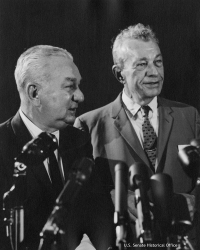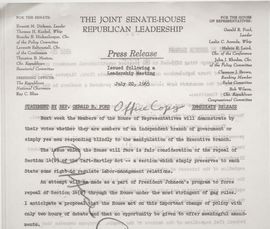
In January of 1961, as President Dwight D. Eisenhower relinquished the Oval Office to incoming president John F. Kennedy, Republicans wondered how they could maintain their influence while serving in the minority during a Democratic administration. The Republican Party “must have a voice while it’s out of power,” Eisenhower stated, and he suggested that such a voice must come from the “collective judgment of the congressional leaders.” Senate Republican Leader Everett Dirksen heeded that advice and established the Republican Joint Congressional Leadership Conference. Each week, Republican leaders met behind closed doors, then the House and Senate minority leaders held a joint press conference. Officially titled the “Republican Congressional Leadership Statement,” this weekly event became known as “The Ev and Charlie Show.”1

Born in Pekin, Illinois, in 1896, Everett Dirksen’s earliest ambition was to go on the stage, but eventually he was drawn to that other theater—politics. “The ambition to sit in Congress is probably similar to the flu,” he once said. “Everybody gets it at some time or another.” He came to Congress as a representative in 1933, then gained national attention in 1950 by unseating Senate Majority Leader Scott Lucas to gain a coveted seat in the Senate. Elected Republican whip in 1957, Dirksen rose to the position of floor leader two years later. Charles Halleck, born in Demotte, Indiana, in 1900, joined Congress two years after his Illinois colleague. Becoming Republican leader first in 1947, Halleck was House minority leader in 1961. Both were conservative Midwestern Republicans serving during an era of Democratic Party dominance. From 1933 to 1969, the Democrats controlled both houses of Congress for all but four years, but that didn’t stop these intrepid leaders from wielding their influence in legislative debates.2
The first meeting of the Leadership Conference took place on January 24, 1961, in Dirksen’s Senate office. When the meeting concluded, Dirksen and Halleck faced the news cameras in the Senate’s old chamber, making statements and fielding questions from reporters. Weekly press conferences by leaders of both parties have become a familiar sight on Capitol Hill, but that practice was less common in 1961, particularly for members of the minority party. At first, the press took a lighthearted view of the weekly events, treating them as a novelty. One reporter compared the two leaders to broken-down Shakespeareans, while another noted that Dirksen and Halleck demonstrated to a whole new generation just “what it was that killed vaudeville.” New York Times reporter Tom Wicker mocked it as “The Ev and Charlie Show,” and the label stuck.3

The frivolous coverage angered Charlie Halleck. “I’m no clown,” he complained, arguing that such parodies were thinly veiled partisan attacks. “The leadership meetings were serious business with Halleck,” noted one historian, “and he wanted them treated as such.” In contrast, Everett Dirksen loved the publicity. He embraced the label of “Ev and Charlie” and encouraged reporters to compare them to other “great American duos” like “corned beef and cabbage” and “ham and eggs.” Dirksen's encyclopedic knowledge and charismatic stage presence served him well in his interactions with the press. He “knew the publicity they were getting simply could not be bought,” explained a biographer, “and that he could turn it to his own advantage.” Instinctively, Dirksen understood that with time the ridicule would diminish while his ability to give voice to the opposition would grow.4

Before long, the “Ev and Charlie Show” was a hit. “Every Thursday morning,” reported the New York Times, “two of this town’s most agile political performers have been taking a turn on-stage and on-camera.” Networks included excerpts of the show on the evening news, and the team received widespread coverage in daily newspapers, as they discussed issues that ranged from civil rights to Cuban affairs, unemployment to Vietnam. Dirksen and Halleck became well-known national figures, but not all of their colleagues were pleased. Some Republicans, in Congress and out, wanted to promote a broader agenda than that offered by the conservative duo, but few denied the fact that Dirksen and Halleck kept the voice of the minority before the public. The leaders also provided bipartisan support for the Kennedy administration during times of national crises. “It was primarily due to Dirksen and Halleck,” commented one scholar, “that Republicans solidly backed Kennedy during the missile crisis in Cuba and during the period of extreme tension when East Germans built the Berlin Wall.”5

By the time the Kennedy administration became the Lyndon B. Johnson administration, the regular broadcasts of the “Ev and Charlie Show” were a mainstay in American politics. In 1965 Michigan representative Gerald Ford replaced Halleck as House minority leader and the show was renamed the “Ev and Jerry Show.” They continued the regular broadcasts until 1969, when Republican Richard M. Nixon became president, but the new rendition never quite captured the magic of the original. As it turned out, Charlie Halleck’s irascible nature proved to be the perfect counterpart to Dirksen’s folksy demeanor.6
For eight years, the show gave Republican leaders a national forum as they tried to find what one contemporary described as that “elusive but important distinction between opposition and obstruction.” Sometimes criticized, frequently ridiculed, but always informative, Dirksen’s weekly press conferences with his House counterpart reminded the public of the importance of the loyal opposition and the relevance of a minority voice. In fact, Dirksen’s influence often matched and sometimes surpassed that of majority-party senators, because—as so many of his colleagues understood—Dirksen was always the star of the show.7
Notes
2. Annette Culler Penney, The Golden Voice of the Senate (Washington, DC: Acropolis Books, 1968), 113. For biographical information, see: Neil MacNeil, Dirksen: Portrait of a Public Man (New York: World Publishing Company, 1970); Henry Z. Scheele, Charlie Halleck: A Political Biography (Hicksville, NY: Exposition, 1966).
3. MacNeil, Dirksen, 187–89; Byron C. Hulsey, Everett Dirksen & His Presidents (Lawrence: University Press of Kansas, 2000), 145–46; “Rules-Unit Fight Nears a Decision,” New York Times, January 25, 1961, 20; “Charlie and Ev,” New York Times, March 12, 1961, E11; “G.O.P. Broadens Attack,” New York Times, May 7, 1961, E12; “Washington,” New York Times, January 9, 1963, 5; “Shuffles at State,” Washington Post, Times Herald, April 2, 1962, A2.
7. Hulsey, Everett Dirksen & His Presidents, 146; Schapsmeier, Dirksen of Illinois, 132–33, 170; “Ev-Jerry Show Won’t Last Long,” Atlanta Constitution, January 14, 1965, 4; “Ford Left Downstage: Dirksen’s Act is Hard to Follow,” Baltimore Sun, September 2, 1966, A4; “Ev and Jerry Show Leaving Air Waves,” New York Times, January 23, 1969, 23.